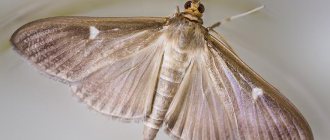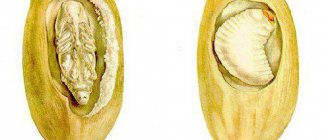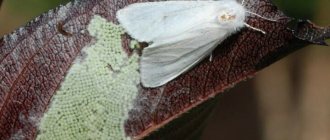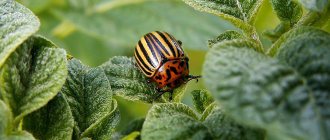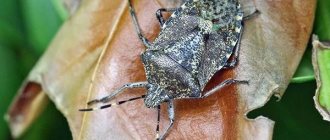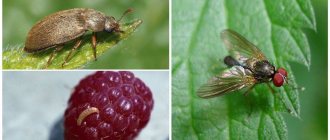Description of the pest
Woodlice have a chitinous shell of grayish tints, divided into several plates. Fast movement is ensured by seven pairs of legs, the last of which serves as a support and a means of protection from enemies. The elongated whiskers allow the crustacean to navigate in space. Small eyes are located in the front of the body on the sides.
When danger arises, the individual curls into a ball and freezes, pretending to be dead. Woodlice lead an evening and nocturnal lifestyle, and during the day they hide under leaves, stones and other suitable shelters.
The crustaceans calmly survive drought, thanks to special air cavities similar to the trachea, replacing gill breathing. Individuals live on average 9-12 months.
Reasons for appearance
A garden plot may attract harmful crustaceans for the following reasons:
- Excess moisture, which can be caused by precipitation, leaking watering hoses, or excessive soil irrigation.
- Poor ventilation in greenhouses, where the air is humidified to 80-90%.
- Open areas for storing waste.
- Compost pits with temperatures below 40 °C.
- Accumulation of various garbage on the territory (remains of cellophane, brick fragments, cuttings of branches).
- Stagnant water in various open containers.
Crustaceans can get into the greenhouse along with soil, manure or humus from the garden.
Features of soil deoxidation
Since woodlice prefers highly acidic and acidic soils, it is most difficult to get rid of it in areas with such soil. Conventional methods cannot be used here, and the situation cannot be improved even with the help of mechanical weeding. However, there is a simple way to remove woodlice weed from the garden in such a situation. It consists of bringing the pH level to neutral. To do this you can use:
- chalk;
- lime;
- eggshell;
- ash;
- dolomite flour;
- old plaster.
With the help of lime fertilizers, you can not only reduce the acidity level of the soil, but also improve its structure. Since all these products are alkaline, they need to be removed in the fall or spring, together with chemicals. Some gardeners from time to time water their cultivated plants with an ash solution (200 g of ash per 10 liters of water). However, this measure is only preventive, since it has a weak effect on the weed.
Damage caused
In the natural environment, woodlice find a sufficient amount of food by eating decaying plants, moss, algae and tree bark. In greenhouses, greenhouses and vegetable gardens, they include spicy herbs and tender vegetable leaves in their diet.
Crustaceans pose a particular danger to low-growing crops that touch the ground with their tops. As the population grows, pests can gnaw plant roots close to the surface and protruding from the ground, leading to the death of crops.
A sign of the appearance of woodlice is the appearance of eaten edges and through holes on the leaves. The result of pests infesting a greenhouse is compaction of the soil. The roots of crops begin to lack oxygen and nutrients.
A small number of crustaceans do not pose a threat to the site, but in the presence of a favorable environment (abundance of weeds, high humidity, debris and plant debris), they can quickly multiply and lead to the death of a significant part of the crop.
Folk methods of struggle
There are a number of folk remedies to combat woodlice:
A solution based on tobacco, soda and red pepper
Having measured out 3 g of each ingredient, mix them with 1 liter of boiling water. The solution is sprayed onto areas of soil where wood lice were found.
Salt
It is scattered in places where wood lice accumulate. This option cannot be used for processing beds.
Dry kvass product
Add 100 g of powder to 500 ml of water. Spray the solution in greenhouses and beds.
Boric acid
Take 10 g of powder and dilute it in 500 ml of water, treat it with the composition of the bed.
Creating Traps
In pest habitats, place rags soaked in water, birch brooms, potatoes or apples with the core removed at night. In the morning, the preparations are thrown away or burned along with the crustaceans that have climbed into them.
Woodlice is a herb that grows in what soil. Description of woodlice
The weed has several names, although the popular definition of “woodlice” fully corresponds to its essence. This is due to the plant’s commitment to shaded areas of soil with good moisture. If the soil is also fertile, then in the warm months the woodlice reproduces very actively. The weed is famous for its vitality and high degree of adaptability. Cultivated species cannot withstand competition and are often quickly suppressed by their harmful neighbor. The thin, highly branched stems of the weed retain moisture (dew) well, which is why the plant received such an interesting name. This ability also allows the grass to survive dry periods.
Scientists classify the chickweed grass as a member of the clove family and define it as “average chickweed” or Stelláriamédia. This is an annual herbaceous plant with small flowers resembling stars in outline.
It blooms in spring and summer, usually from May to the end of August. Seeds are formed in boxes. They can be either kidney-shaped or round in shape. Like any weed, woodlice produces a lot of seeds. Up to 15 thousand of them can ripen on one plant. The seeds retain their viability for 5 years.
Woodlice reproduces vegetatively. Any part of the stem takes root and forms a new plant.
Characteristics of the weed that describe its features:
Important! If there is a wood lice in the area, you need to be extremely careful. Even a small piece of shoot, carelessly thrown onto the ground, produces new full-fledged stems.
There is another popular name for the weed - bird's lettuce. Feathered pets eat chickweed with great pleasure. This suggests that the plant contains many useful components.
Chemicals
If you cannot cope with harmful crustaceans using simple methods, you can use contact-intestinal chemicals.
Granules "Thunderstorm"
Anti-slug insecticide based on metaldehyde, also effective for killing woodlice. The consumption of the product is 5-6 g per area of 10 square meters. m.
Granules are scattered in the spring around seedlings planted in the ground. The insecticide is left on the ground for up to two weeks and then collected and burned. You can repeat the procedure 2-3 times per season. Analogues of the drug are Chinese “Metaldehyde” and Swiss “Meta”.
The drug should not come into contact with edible plant foliage, as it can cause poisoning in humans if consumed.
Means "Ulitsid"
Consists of a mixture of grains, mustard, wood ash, black pepper, sugar, salt and hops. The main active ingredient is iron phosphate, which causes dehydration in pests and is completely processed by microorganisms in the soil.
The advantage of the composition lies in its safety for the environment and human health. The unpleasant smell of the mixture also prevents it from being eaten by animals. The granules are resistant to precipitation and are highly effective. The drug is scattered between rows at a rate of 3-5 g per 1 square meter. m. One treatment per season is enough.
Insecticide "Fozalon"
Effectively destroys crustaceans in 48 hours due to high toxicity and long-term protective effect (15-30 days). It can work even at low temperatures (10-12 °C). The product does not cause burns on plant leaves.
"Fozalon" is suitable for processing citrus, industrial, fruit and grain crops. Vegetable plants can only be protected if they are grown for seeds. Berry bushes are sprayed before the flowering period or after the end of the harvest.
The drug "Fozalon" should not be combined with alkaline agents.
The working solution is prepared at the rate of 5 ml of 35% emulsion per 5 liters of water. The treatment is carried out in calm, cloudy weather. Plants are protected during their growing season, 1-2 times, in the morning or evening.
When spraying, you must use protective clothing, a respirator and gloves.
Information about the woodlice plant
The scientific name of the common woodlice is chickweed. Its other names are associated with some medicinal properties and a predisposition to rapid growth on moist soils - woodlice, midge, midge, hernia grass, heart grass.
A low herbaceous plant with succulent stems and small rounded leaves. It blooms throughout the growing season with small, star-shaped white flowers. From the beginning of flowering to the complete ripening of the seeds, 4-5 weeks pass, then the next cycle begins, and so on throughout the growing season. About 15,000 seeds can ripen on one bush per season.
Information! The seeds are very resistant to external factors and remain viable in the soil for a long time, from 2 to 5 years. For germination, a temperature of +4°C is enough for them, so they germinate earlier than other plants.
Expert advice
Which method of dealing with woodlice would you choose?
FolkChemical
The following preventive measures will help you avoid the appearance of woodlice in your garden plot:
- Timely weeding of beds.
- Renewing the soil in greenhouses and greenhouses, avoiding excessive watering, regular ventilation, removing plant debris and debris.
- Minimizing soil fertilization with peat and tree bark.
- Cleaning the area from rotten tops, fallen fruits and vegetables.
- Removing rotting lumber from the area and uprooting old stumps.
- Storage of household waste in containers with lids and their timely cleaning.
- Adding manure to compost pits. It will increase the temperature of the rotting plant mass to a value unsuitable for woodlice.
- Spring treatment of row spacing with “Metaldehyde”, protecting young shoots from being eaten.
It is necessary to keep the garden clean, promptly remove accumulated debris and weeds, and prevent the soil from becoming waterlogged. Preventing the appearance of pests is much easier than eliminating the consequences of infection.
How to get rid of woodlice on your property
In a few days, woodlice will cover the fertilized bed with lush greenery so that the seedlings of the sown crops will be lost in the cool emerald carpet of Stellaria media (that is the beautiful name given to the hated weed in Latin). There is no dispute, the herb is very good for health, contains so many vitamins, and is used to treat many diseases. But, if we are talking about the cleanliness of garden beds, then the reaction of summer residents is the same: eradicate, destroy, get rid of woodlice on the site forever.
And this is not an easy task, because the unpretentiousness of the grass allows it to grow in any conditions. And the worse these conditions are (hardened dry soil, poor soil), the more difficult it is to free the soil from the network of tiny roots that penetrate every centimeter. The woodlouse fights for life no less desperately than a gardener fights the woodlice itself in the garden beds.

